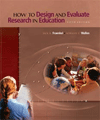 |  How to Design and Evaluate Research in Education, 5/e Jack R. Fraenkel,
San Francisco State University
Norman E. Wallen,
San Francisco State University
Single-Subject Research
Learning ObjectivesStudying this chapter should enable you to:
| Describe briefly the purpose of single-subject research. |
 |  |  | | Describe the essential characteristics of such research. |
 |  |  | | Describe two ways in which single-subject research differs from other forms of experimental research. |
 |  |  | | Explain what a baseline is and why it is used. |
 |  |  | | Explain what an A-B design is. |
 |  |  | | Explain what a reversal (A-B-A) design is. |
 |  |  | | Explain what an A-B-A-B design is. |
 |  |  | | Explain what a B-A-B design is. |
 |  |  | | Explain what an A-B-C-B design is. |
 |  |  | | Identify various threats to internal validity associated with single-subject studies. |
 |  |  | | Explain three ways in which threats to internal validity in single-subject studies can be controlled. |
 |  |  | | Discuss the external validity of single-subject research. |
|



 2003 McGraw-Hill Higher Education
2003 McGraw-Hill Higher Education